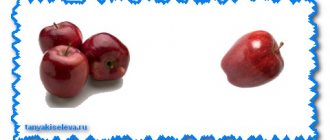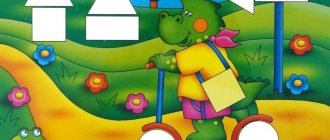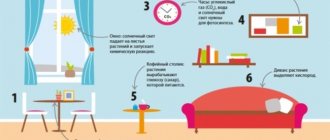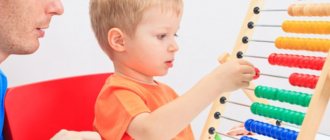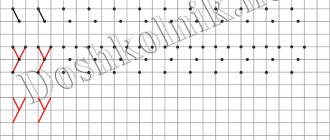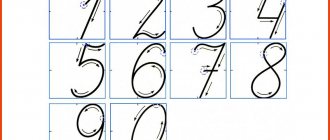You can start getting acquainted with the number 9 in an unusual way. Offer your child riddles, sayings, proverbs, puzzles, tongue twisters, poems, etc. For children who go to 1st grade, a presentation dedicated to the number 9 will be interesting. It is possible to interest a child in learning, but this will require effort.
Introducing numbers and numbers
Nine is the last digit in a series of single digit numbers. Acquaintance with it should occur when the previous eight have already been studied.
Before moving on to studying nine, you need to repeat and consolidate the material you have covered, solve examples on adding and subtracting single-digit numbers.
The child must know the answer to the question: what is the difference between a number and a digit and how many digits there are.
The lesson is conducted in an interactive form, using the following materials:
- educational games;
- puzzles;
- puzzles;
- Proverbs and sayings;
- simulators for the development of thinking, etc.
To make it comfortable for a child to study and easier to assimilate information, it is necessary to create an environment suitable for learning, eliminating extraneous sounds (TV, phone, tablet, etc.). You should create a working atmosphere in the room. It is not advisable to conduct a lesson in a children's room, where there are many toys and other elements that distract attention.
It is better to sit at a table in a large, bright room. During the lesson, you need to take short breaks and engage in physical activity during this time. This is due to the fact that a preschool child gets tired quickly and it will be difficult for him to sit in one position for a long time.
During the lesson, the child must master writing the number nine, learn how to perform arithmetic operations with it, concentrate attention on an object and complete tasks independently.
As educational material you can use:
- training video;
- books on mathematics for preschoolers;
- interactive maps;
- copybooks, coloring books;
- computer games.
The material should be presented in such a way as to interest the child. This is due to the fact that children cannot concentrate on what is not interesting to them. Perseverance and attentiveness must be developed gradually.
After the lesson, the child should:
- know the composition and formation of the number 9;
- be able to correlate the number of objects and objects with the number;
- be able to break a number into its components.
Tasks about numbers
So, what tasks will you need to complete?
- Count the multi-colored rectangles (there are 9 of them).
- Find all the numbers nine hidden among other numbers and circle them.
- Draw 9 multi-colored stripes on the sock.
- Find all the numbers 9 hidden in the hearts.
- Circle the big number nine, starting from the arrow 9 times.
- Find two numbers 9 hidden in the picture with scissors and color them.
- Draw nine balls for the juggler girl.
You can download the tasks about the number 9 here.
Author's assignments about the number nine for children.
Here you need to first circle the numbers 9, and then count the number of pictures and circle those that have 9 each.
As an addition to the lessons, I recommend watching a funny cartoon from Auntie Owl from Baby Arithmetic about the number nine.
Searching for associations to facilitate understanding
To make it easier for a child to learn and remember nine, you need to make a series of associations with familiar objects and phenomena. Poems and pictures with the number 9 will help with this.
You should draw the child's attention to the fact that 9 looks like an inverted six.
You can also draw a parallel between nine and the letter D. Thus, the child will quickly remember not only numbers, but also letters.
Examples of what a 9 is like include:
- comma;
- elephant head with trunk;
- half a pretzel;
- a ball of thread;
- fish caught on a hook;
- seahorse;
- number 0 with a tail;
- open lock;
- ear;
- earring, etc.
Thanks to associative thinking, the memorization process is greatly facilitated.
What does it look like?
An interesting question to ask your child is: what does the number 9 look like?
Probably the first answer will be “to the inverted number 6.” And then we’ll start comparing with objects and phenomena. Photos of various objects that look like a nine, puzzles where numbers are often encrypted using other words and concepts, the number 9 in pictures, etc. can be a great help with this.
There are many more different tasks where the number 9 is involved.
Riddles will help you develop your intelligence and count to 9 at the same time. It is riddles as a genre of folklore that provide rich food for the mind. Read the riddles to the children and let them guess what number they are talking about. Riddles will help start the lesson in an interesting way so that the kids get involved in the work.
Sayings, proverbs, tongue twisters, and poems will help develop speech and diction in the classroom. They will not only teach you how to count to 9, but also how to pronounce sounds correctly and construct sentences. An interesting poem by S. Marshak “Merry Counting”, where all the numbers are present, but you can only take from it an excerpt that describes the number 9. Other authors also have poems, for example, A. Barto. You can download poems about the number 9 on our website. Ask the children at home, together with their parents, to find poems about numbers. Poems will also help you start a lesson in an interesting and unexpected way if you, as a teacher, are teaching children in 1st grade.
Proverbs and sayings, which are usually edifying in nature, can be used in the middle of class or as homework. It would be interesting to suggest depicting what proverbs and sayings are about in pictures. Let the kids draw at home how they understand the given proverbs and sayings. They will also have to practice writing the number 9 to depict the content of folklore works.
Number 9 in English.
Origami: how to fold the number 9 from paper.
Tongue twisters will help children develop speech. You can also download tongue twisters on the website. Offer them to the kids as a break between writing or other types of work.
Coloring with the number 9 will help develop fine motor skills, accuracy and creative thinking. The baby not only learns and remembers the number, but also learns to trace drawings along the contour and color without going beyond the designated lines. Coloring is an excellent preparation before a child begins to learn to write. The coloring book will also serve as homework for preschoolers or children attending 1st grade. Many teachers are inclined to believe that coloring books are no longer relevant for school: copybooks are taking their place. However, in vain: coloring can be an excellent tool for an integrated lesson in mathematics and drawing.
You can study the number 9 by offering your child puzzles. The puzzles themselves represent an encrypted word, in this case, the number 9. Solving the puzzles requires a lot of ingenuity.
To learn how to write the number 9, your child will definitely need copybooks. Have him try circling the number before writing on his own. Then let him write on his own. Stimulate your child, praise him more often, then everything will probably work out.
Simple problems for numerals
Simple tasks for preschoolers will help them master new material:
- There were 6 puppies in the booth. Then 3 more puppies were brought there. How many puppies are there in the kennel?
- Small houses are drawn on a piece of paper. Some of them have numbers and others don't. You need to return the missing signs to the houses by writing them in the correct field.
- The following examples need to be solved: 8+1, 5+4, 6+3, 7+2.
- Sveta had 3 pencils in her box. Zhenya gave her 6 pencils. How many pencils did Sveta have in her box?
- There were 9 ripe pears hanging on the tree. Maxim picked 2, mom took 3 for the pie. How many pears are left on the tree?
- The children picked 8 red tomatoes and 1 green one from the garden. How many tomatoes did the children collect?
Poems about the number 9 for 1st grade
The wind blew and blew strong, and Cherry turned over. The number six, pray tell, has turned into the number nine.
Number nine, or nine, Circus acrobat: If she stands on her head, Number six will become nine.
No more than this number! Nine balls - planets According to physical laws They circle in bottomless space Near the solar star And on the third, Me and you!
Start writing from a circle, but don’t make a corner. The nine has no corners: a circle, an arc - and the sign is ready!
One day we decided to trim the curls of NINE rather overgrown lambs. The wool was cut from their backs and sides: It turned out to be almost NINE bags.
My grandmother and I are walking along the street, counting the windows in the house from bottom to top. What a big beautiful house, there are exactly NINE windows in it!
Where can we find nines, friends? Why are they playing hide and seek? I looked for them everywhere, it seems, But nines don’t exist in nature. Sorry for the mistake, I see a nine-story building!
The number nine is not simple, like a big comma. She's friendly with frogs - she's a tadpole! This figure is simply awesome! Turning like an ace, Becoming a six, like a lock, Closes the doors at night.
Nine, like six, Take a closer look. Only the tail is not up, but down.
The cat lay down on the ledge, his fluffy tail hung down. Kitty, cat, how much you look like a nine!
There lived a nine in the little house: She loved to sleep sweetly and sweetly. A red bow over the top of the head, a cheerful tail. Once she had a dream: A wonderful forest from all sides, Nine rainbow dragonflies wove a wreath of roses for her, Nine fast perches played with her on the waves, Nine ducks flew with her, Nine foxes rolled her, Nine bright moths came down to her with clouds And then an elephant stomped and scared away the wonderful dream!
Nine boys in the entrance - They play together in the yard, And from the balconies Nine grandmothers look at the children.
Nine - See for yourself Looks like six Upside down, Looks like a door hook, Looks like an upside down lock.
By nine to ten, by nine to ten, by nine by ten You have to go to school. At nine the bell rings. The lesson begins.
The children decorated the Christmas tree and counted the toys. One - an elephant hanging on a branch, Two - a crystal snow house, Three - a flashlight with a light, And four - an important gnome. Five - cheerful Santa Claus! What did he bring us in the bag? Six is a nut, and the seventh is a golden bell. Eight is a ball, covered in snow, as if it was caught in a snowstorm. And the ninth, look, the star is burning above!
Composition of number 9
Nine has a birthday, the numbers are all in great confusion. What to do? How should they be? What to give to the nine? Numbers one and eight came to visit. They gave her a bouquet and stood next to her on the parquet. We danced, played and changed places. Two friends came to nine on this day: two and seven. They gave me a suitcase and sat down on the sofa. They sat, creaked, and quietly moved. Three and six came and read poems in her honor. Two neighbors sat down next to each other and treated themselves to grapes. We sat, laughed and changed places. Here are four, together with five, hurrying to play quickly. They gave her paintings and everyone sat down in the living room. We sat and looked, lo and behold, and also moved. The guests are all sitting decorously. They are looking at the nine. Even though nine is the largest, But without all these numbers we won’t get the number nine. Remember all this, children!
Numbers live on various objects: In calendars and tram tickets, On watch dials, on houses, Numbers are hidden in book volumes, And in a store, and on a telephone, And on a car, and on a carriage... Numbers are everywhere, numbers are all around. We will look for them and find them right away.
See also:
Poems about the number 8 for 1st grade
Poems about the number 6 for children
Riddles with the number 5 for school
Math project for 1st grade - Number 5
Strengthening trainers
To consolidate the material covered, you need to practice a lot. Special simulators for improving writing skills will help with this:
- Training manual “Universal simulator. Numbers and counting." S.V. Petrenko.
- Exercise book “Write and erase! I’m learning numbers.” Published by Clever.
- Materials for children's development. Numerical simulator “Entertaining spins. We count from 1 to 10."
- Transparent copybooks “Writing numbers.” V.A. Belykh.
- Coloring simulator “Pig”. O.M. Nosova.
- Complex simulator "Mathematics". ON THE. Latysheva.
- Cards “Find and recognize numbers up to 10. Reinforcing numbers.”
- "Counting within 10. Solving exercises." Author's programs O. Lysenko.
- “Numbers and numbers. Let's learn to count." O. Zemtsova.
- "Mathematical simulator." School for preschool children.
These materials help to study oral and written arithmetic. The tasks that are given in them are suitable for children of preschool age, as well as for those who have entered 1st grade. Thus, children can take a preparatory course at home before entering school.
If a teacher or parent wants to make sure of the quality of the knowledge acquired, you can take an online test or test the child yourself.
Video sequence
A presentation in pictures and photos will help teach children to write and count to 9 correctly. The presentation can be useful if you are a teacher and are going to a lesson in 1st grade. The presentation can also be used at home. You can download it on our website. The presentation is an excellent video guide if you don’t know where to start teaching the number 9.
Thus, learning what the number 9 looks like with preschoolers or children who go to 1st grade can be fun and interesting. Use available tools for this, count, show pictures and photos, study tongue twisters and proverbs . Your child will not only master mathematics, but also receive full development.
The goal is to train children in using mathematical knowledge about the number 9 and the number 9, about geometric shapes in the surrounding space. Objectives: • educational – to consolidate children’s knowledge about the number and number 9; learn to write the number 9; practice solving problems and examples on adding and subtracting single-digit numbers; improve knowledge about the composition of the number 9, about geometric shapes; learn to compare numbers; learn to solve mathematical riddles; • developing - develop logical thinking, attention, memory, imagination; develop the ability to find geometric shapes in the surrounding space; improve the grammatical structure of speech; • educational - to cultivate motivation to learn, perseverance, listening skills; cultivate patriotic feelings and love for one’s hometown. Visual teaching aids, technical teaching aids: image of the number 9, table “Composition of the number 9” (by number of children); checkered workbooks; geometric shapes (circle, square, rectangle, triangle); projector, laptop. Progress of the lesson
1. Organizational moment. - Hello children. Let's start our math lesson. Be careful. Remember to raise your hand if you want to answer or ask. Answer questions in complete sentences.
2. Announcing the topic of the lesson. - We will continue to get acquainted with the number 9 and the number 9. - Guys, why do you go to the Znayka School? (To learn to read, count, to know everything). — Where else in our city do they teach children? (In kindergartens, schools).
3. Mathematical warm-up. — How many kindergartens are there in our city? (7). — How many schools are there in our city? (4). — What is more: schools or kindergartens? (Kindergartens). - Name the neighbors of the number 7; neighbors of the number 4. - What number comes after the number 8? — Count from 1 to 9. — Count from 9 to 1. — What are the numbers from 1 to 9 called? Why? (Unambiguous, because they are written using one sign, one number). - Name the number that comes after the number 9. (10). — What is the name of the number 10? Why? (Two-digit, because it is written using two characters, two numbers). "Fun" puzzles. Three yellow-eyed daisies, five puppies and a mother husky. Two cheerful cornflowers. How many will it be, count it? (6) Now tell me, children, how many flowers are in the bouquet? (5)
4. Getting to know the composition of the number 9. – Many modern and beautiful houses are being built in our city. — Every resident has neighbors. We already know all the neighbors in the houses where the numbers from 2 to 8 live. Let's help populate the house where the number 9 lives. These animals will help us populate the house. Did you find out who it is? (Beavers). Remind children of the correct position of the notebook, hand, pencil, and posture when writing. Each child has a table “Composition of the number 9”.
— For the 30th anniversary of our city, a new house was built. Now there are 100 houses in our city.
Write the numbers 9, 30, 100 on the board.
— Is the number 9 one-digit or two-digit? — What will the number 30 (how old the city is) be called? Why? — What will the number 100 be called? Why? (Three digits). - Remember this.
Physical exercise: Get up quickly, smile, Stretch higher, higher. Come on, straighten your shoulders, raise them, lower them. They turned left, right, and touched their knees with their hands. They sat down and stood up, they sat down and stood up and ran on the spot.
5. Children writing the number 9.
There is a picture of the number 9 on the board.
- The number 9 is indicated by the number 9. - There is such a funny poem about the number 9.
- Number nine or nine - Digital acrobat: If she stands on her head, Number six will become nine.
Show this trick to the children. Remind children of the correct position of the notebook, hand, pencil, and posture when writing.
Air letter.
— Place the pencil just below the upper right corner. From the upper right corner we draw an oval to the left, go down to the middle of the cell, return to the beginning of writing, go down to the middle of the cell, round the “leg” of the number to the left. - Open your workbooks and write the number 9 three times.
Gymnastics for fingers.
6. Solving examples in notebooks, one child at the board.
3 + 2 = 5 7 — 3 = 4 6 – 5 = 1 8 + 1 = 9
7. Working with geometric shapes.
— I’ll tell you mathematical riddles. What geometric figure are we talking about?
1. I am like a hoop, a wheel, like a wonderful ring. (Circle) 2. Three tops, three corners, three sides - here I am! (Triangle) 3. I am neither an oval nor a circle, I am a friend to the triangle. I am the brother of the rectangle, and my name is...Square! 4. I have 4 corners, like a square, But I don’t dare call myself a square, But it still looks like a square, by the way, I have 2 long sides and 2 shorter ones! (Rectangle).
Geometric shapes are attached to the board: circle, triangle, square, rectangle.
8.Result of the lesson. - Our lesson has come to an end. - What did we talk about today? (About the number and number 9, solved examples, recognized geometric shapes) - You guys did a good job.

